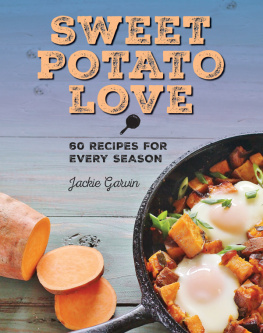Also by Jackie Garvin Biscuits: Sweet and Savory Southern Recipes for the All-American Kitchen
Copyright 2016 by Jackie Garvin Photographs copyright 2016 by Jackie Garvin All rights reserved. No part of this book may be reproduced in any manner without the express written consent of the publisher, except in the case of brief excerpts in critical reviews or articles. All inquiries should be addressed to Skyhorse Publishing, 307 West 36th Street, 11th Floor, New York, NY 10018. Skyhorse Publishing books may be purchased in bulk at special discounts for sales promotion, corporate gifts, fund-raising, or educational purposes. Special editions can also be created to specifications. For details, contact the Special Sales Department, Skyhorse Publishing, 307 West 36th Street, 11th Floor, New York, NY 10018 or .
Skyhorse and Skyhorse Publishing are registered trademarks of Skyhorse Publishing, Inc., a Delaware corporation. Visit our website at www.skyhorsepublishing.com. 10 9 8 7 6 5 4 3 2 1 Library of Congress Cataloging-in-Publication Data is available on file. Cover design by Jane Sheppard Cover photo credit: Jackie Garvin Print ISBN: 978-1-5107-0966-9 Ebook ISBN: 978-1-5107-0972-0 Printed in China  Dedicated to Sam Garvin Forty years of marriage, Three children by birth, Two children by marriage, Three grandchildren, Two bassett hounds, Innumerable happy times shared and doubled. Heart-wrenching sad times shared and halved. Amen.
Dedicated to Sam Garvin Forty years of marriage, Three children by birth, Two children by marriage, Three grandchildren, Two bassett hounds, Innumerable happy times shared and doubled. Heart-wrenching sad times shared and halved. Amen. 
 CONTENTS
CONTENTS  Sweet Potato Life
Sweet Potato Life  S weet potatoes have always been a part of Southern culture and foodways.
S weet potatoes have always been a part of Southern culture and foodways. 
 CONTENTS
CONTENTS  Sweet Potato Life
Sweet Potato Life  S weet potatoes have always been a part of Southern culture and foodways.
S weet potatoes have always been a part of Southern culture and foodways.
They were one of the native American plants discovered by Christopher Columbus on his voyage to America. Evidence shows that sweet potatoes were included in the first Jamestown feast, a celebration that occurred a few years after the establishment of the colony in 1607. Sweet potatoes were not popular in Europe and not suited to the climate, so the English settlers were not familiar with them. The largest local tribe of Native Americans, the Powhatan Confederacy, taught the settlers how to cultivate sweet potatoes. Just as the Jamestown, Virginia, settlers discovered soft winter wheat that eventually transformed biscuits from hard tack to the highly favored modern biscuit, which is soft and flaky, those settlers adopted the sweet potato introduced to them by Native Americans. The sweet potato has been a part of Southern culture ever since.
Another similarity to biscuits is that for a long while, sweet potatoes popularity in the United States was limited to the southern states but now enjoys nationwide rock star status. Nutrition The nutritional composition and low glycemic index of the sweet potato make it suitable for most any type of diet. Additionally, the versatility of the sweet potato makes it well-suited for all types of dishes: sweet and savory, appetizers, main courses, desserts, snacks, and breakfast. The Center for Science in the Public Interest (CSPI) ranked sweet potatoes as the number one vegetable in nutrition out of eighteen vegetables studied. Rich in antioxidants, anti-inflammatory nutrients, and blood-sugar regulating nutrients, sweet potatoes are power boosters and superfood heroes. Theyre a key source of beta-carotene and an average serving (3.5 ounces) may supply the recommended daily requirements of vitamin A.
Theyre also an excellent source of vitamin C and potassium. I Yam What I Yam With a tip of the hat to Popeye, the Sailor Man, the sweet potatos classification might be surprising. The vegetable many called yams that makes an appearance on modern Thanksgiving tables in the United States isnt a yam at all. Its a sweet potato. The contents of the can of yams used to make candied yams doesnt contain yams either. These are sweet potatoes, too.
Check the label. The contents are sweet potato, water, and usually some sugar. People will argue that the fresh product in the grocery store is a yam if its lighter in color than bright orange, but a yam is yam. A sweet potato is a sweet potato. They arent even distant cousins. A true yam is starchy, dry, and white fleshed with rough and scaly skin.
The flesh isnt very sweet. A sweet potato has smooth skin and the sweet, moist flesh can range in color from white to orange to purple. Its unlikely that true yams are produced commercially in the United States. Theyre primarily grown in Africa, Asia, and the Caribbean, but theres a slew of sweet potato farmers in the United States, primarily located in North Carolina, Louisiana, Mississippi, and California. In addition, backyard sweet potato gardeners abound. Yams are of the genus Diascorea .
Sweet potatoes are of the genus Ipomoea and are closely related to the morning glory. The blooms and leaves are similar. Once I ordered yams in Barbados, West Indies, from a restaurant menu prior to my knowledge of the difference in true yams and sweet potatoes. At that time, I thought they were the same and expected sweet potatoes. I remember leaving the restaurant thinking they must have received a bad shipment of the worst sweet potatoes in the world.  Roots versus Tubers We eat the part of the sweet potato we call the root.
Roots versus Tubers We eat the part of the sweet potato we call the root.  Roots versus Tubers We eat the part of the sweet potato we call the root.
Roots versus Tubers We eat the part of the sweet potato we call the root.
This is where all its nutrients are stored. Since the sweet potato is a root, unlike the white potato thats a tuber, the sweet potato isnt able to produce eyes. Instead, it puts off new growth known as slips. Planting and Growing Unlike white potatoes, which prefer a cooler environment, sweet potatoes are tropical plants that thrive in hot climates. They dont like rich soil and will perform the best in sandy soil. Planting takes place after all danger of frost is over.
Sweet potatoes are cultivated from a slip, which are seedlings cut from the mature sweet potato. The vines grow rapidly and produce a ground cover. Once the plants are established, they require little care outside of weekly watering. They grow for three to four months before reaching a suitable size to harvest. Harvesting, Processing, and Curing Sweet potatoes are ready for harvest in the fall. Stored in optimal conditions, theyll last about eight months.












 Dedicated to Sam Garvin Forty years of marriage, Three children by birth, Two children by marriage, Three grandchildren, Two bassett hounds, Innumerable happy times shared and doubled. Heart-wrenching sad times shared and halved. Amen.
Dedicated to Sam Garvin Forty years of marriage, Three children by birth, Two children by marriage, Three grandchildren, Two bassett hounds, Innumerable happy times shared and doubled. Heart-wrenching sad times shared and halved. Amen. 
 CONTENTS
CONTENTS  Sweet Potato Life
Sweet Potato Life  S weet potatoes have always been a part of Southern culture and foodways.
S weet potatoes have always been a part of Southern culture and foodways.  Roots versus Tubers We eat the part of the sweet potato we call the root.
Roots versus Tubers We eat the part of the sweet potato we call the root.